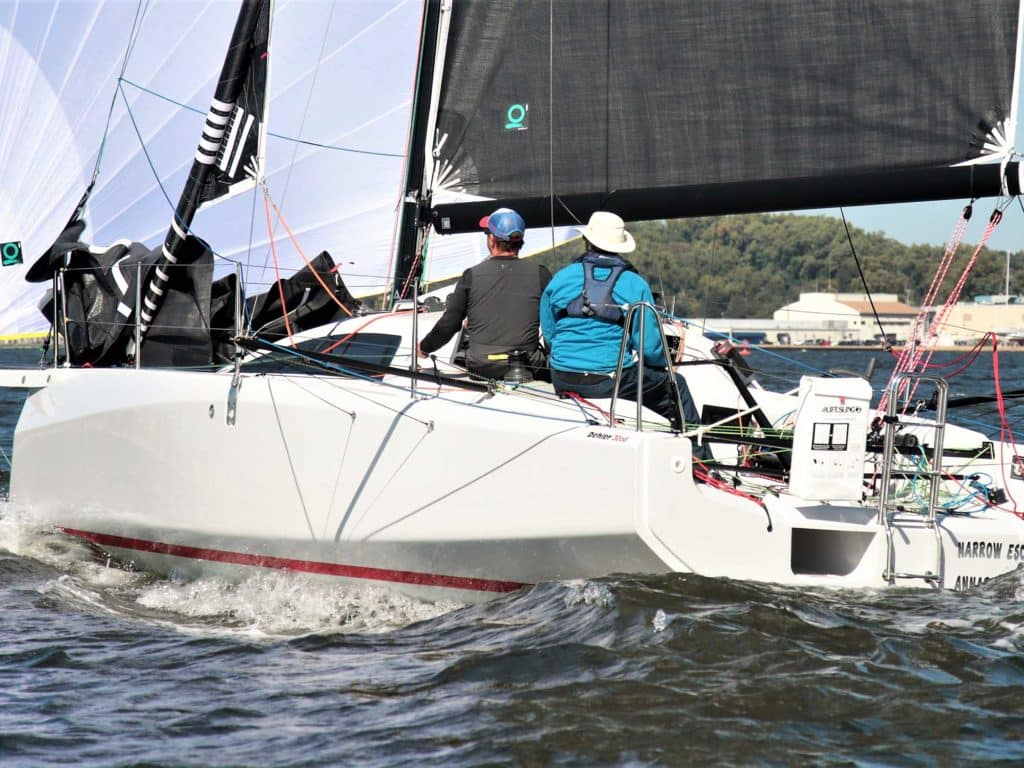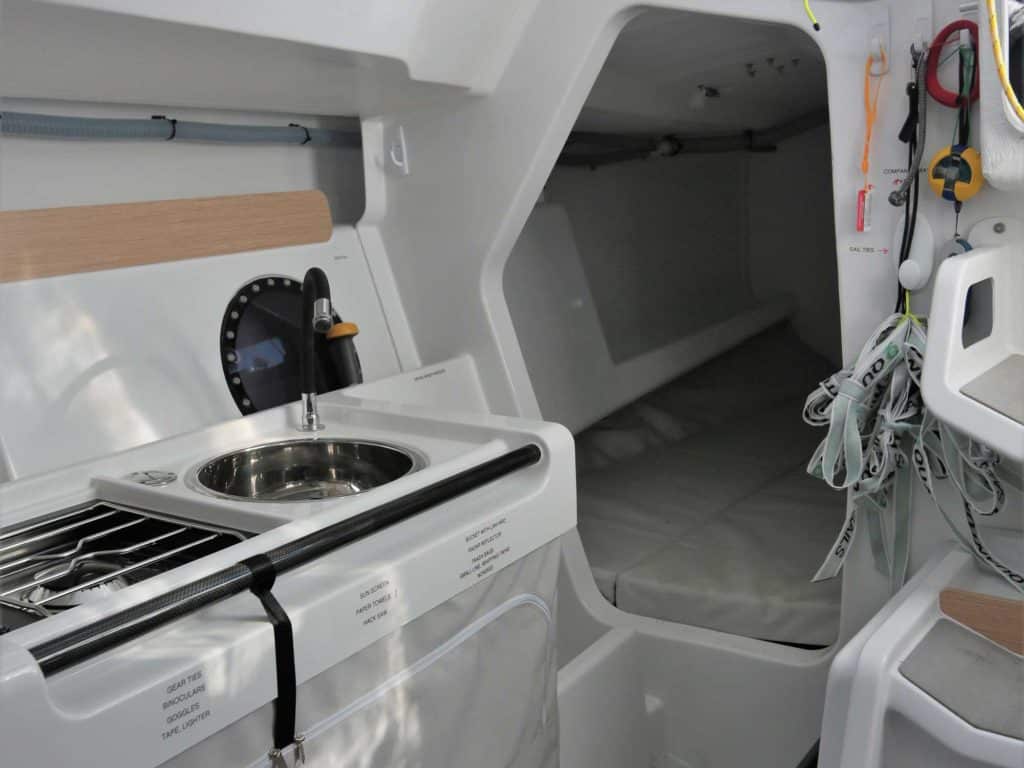
Ben Corson and his partner Marta Hansen have for many years enjoyed sailing and racing a wide diversity of boat types, from a Flying Scot they keep on Deep Creek Lake in western Maryland to a series of larger and faster boats they sail on Chesapeake Bay. This latter group includes a J/125, an Open 6.50, and a Dragonfly 25 Sport trimaran. All have had their particular strengths within each genre of sailing – an offshore-capable keelboat, a lively sportboat, and a fast multihull, with the common element for all being high speed under sail.
“I do like going fast,” Corson confesses, while also admitting to taking fast cars around a racetrack a time or two.
So, his latest boat, named Narrow Escape, had to be quick, and yet he was looking for much more than just speed in a boat within the 30-foot range. The approach he took in his search was an academic one: lay out in a spreadsheet all the specifications, features and attributes of the candidates, placed alongside some known benchmark designs.
The designs in his study included the Jeanneau SunFast 3300, the L30, the Italia 9.98, the J/99, the Figaro Beneteau 3 and the brand-new Dehler 30. He had seen these in the 2019 Fall boat shows, as well as around town in Annapolis. In the race results at home and abroad there had been some impressive wins in PHRF and ORC, the two systems most widely used in the Chesapeake: Laurent Givry and Sidney Gavignet, for example, won overall in the 2019 Annapolis-Newport Race in La Defonce, Givry’s Figaro 3, in PHRF scoring; Ken Read and Suzy Leech won their class in the 2020 Ft Lauderdale-Key West race in the SunFast 3300 in ORC scoring; and Italia 9.98s were gold medalists in the 2015 and 2016 ORC Class C World championships.
And while World Sailing’s Offshore World Championship has yet to be run, L30s were selected over a year ago, to be used for this new event, while J/99s have done well in the UK racing under IRC. In contrast, the Judel/Vrolijk-designed Dehler 30 was getting a lot of advance attention, but the first boat off the production line in Germany did not make its debut until late January 2020, so there were no race results to consider in the study. Nonetheless, Corson made it clear that rated performance was of secondary concern.
The benchmark designs he used were the venerable but still solid Farr 30 and the versatile and the very quick Melges 32, both proven performers in a variety of settings. He reckoned the process of deducing performance potential in the candidate designs would be easier with parametric points of reference in ratios such as SA/DSPL, DSPL/L, etc.
Since Corson and Hansen are often sailing doublehanded, the favored design would need a deck layout and other features to support making this an easy mode of sailing with minimal compromise in performance. With this being a strong criteria, Corson’s choices whittled down quickly to the SunFast 3300, Figaro 3 and Dehler 30. After test drives on the two French-built designs, he’s opted for the German-built Dehler 30.”The biggest factor in our decision was the emphasis in the design brief about this boat being good upwind, good all-around in light to moderate air, and capable of planing offwind in a breeze,” he says. “This was a big deal for us in this area because without speed in those conditions you’re not going anywhere around here. Also, since we rarely have long legs of heavy-air reaching, the form stability in the wider boats translates to drag in our lighter conditions here, and the Dehler seems to have a more balanced hull form to get the stability when needed without excessive form drag when it’s not.”
For Corson, one attractive feature in the design plan is the use of carbon fiber reinforcement in the hull substructure. Besides giving more strength to tie together the rig and keel loads without adding too much weight, this allows for an open interior with only a ring frame separating the forward cabin from the main salon. The mast is deck-stepped, so there are no mast partners to leak and creak, and the compression post is smaller than a full-sized rig section to also minimize the impact on interior spacing.
Likewise, the interior pan design includes longitudinal reinforcements along the settee fronts that extend to the ring frame, and the V-berth and its structure is not only long and spacious enough to be functional, but also provides bow panel stiffness all the way forward to the watertight collision bulkhead at the bow, interrupted only by a carbon tie rod that anchors the inner headstay loads to the hull.
Features like these and the modern stylish layout make this boat feel much larger than its 30 feet, and even makes a convincing case for short-term couples cruising comfort.
There were other features standard to the Dehler 30 that attracted Corson: lightweight and energy-efficient lithium phosphate batteries, less than half the weight of conventional AGM battery power units, and the small but efficient 2-cylinder Nanni inboard diesel engine. One might wonder how an engine that weighs only 87 kg (191 lbs.) and delivers 10 hp can be an effective powerplant for a boat this size. This is due to the efficiency of yet another really cool feature normally found only on high-tech custom raceboats: the retractable propeller and shaft assembly called the “stealth drive.” This clever system deploys the shaft and efficient three-blade propeller downward away from the hull when needed, and lifts it back up into its position flush with the hull, allowing for both fast powering and drag-free sailing.
“I’ve always worried about drag, and had small folding props on raceboats,” Corson says. “Having a cruising prop available when you need it is outstanding, especially when it can disappear when you don’t need it.”Anticipating only two crew on board for double-handed sailing means stability upwind and reaching has to come from a source other than hiked crew. Some of this is produced by the hard chines in the hull shape that carry the hull volume further outboard to achieve form stability when the boat starts to heel, yet when upright is not dragging too much through the water in light air. This design strategy seems to work, since the measured stability index is about 117, just exceeding the minimum 115 needed for being compliant with the offshore category of safety regulations.
However, this boat powers up quite quickly with its generous sail plan, so achieving stability without more crew weight is important. The Dehler 30 uses water ballast tanks, which are certainly not new technology, but it can be a challenge to find the correct tradeoff of the amount of weight needed to achieve stability and where to place the tanks where they will optimize the sailing trim without adding weight. To do this, Judel/Vrolijk placed the tank at about the companionway position and outboard at about the chine, with 200 liters (53 gal) determined to be the optimum amount: not so much to add excess weight and take too long to move side-to-side, but just enough to offset the righting moment produced by about three hiked crew.
Another interesting feature is when the boat does heel, the small twin angled rudders come into their own: the leeward rudder is at the perfect angle and correct size to keep the boat tracking with little helm and no cavitation. Corson claims he’s yet been unable to broach the boat because the rudder remains fully immersed all the time. And the added drag of the windward rudder is minimized by its low-aspect design geometry. He also finds the tiller helm in good balance, with a level of responsiveness akin to single-rudder designs.
Besides what Corson terms the “Euro-styling” of the boat having its reverse full bow, long chines, fixed bowsprit, dual rudders, low-profile angled cabin house, full stern and dual rudders, what also stands out is its huge sail plan and its proportions. A large square top main of 33.5m2 and 98.3m2 asymmetric spinnaker flown from the end of the carbon bowsprit that is fixed 1 meter out from the stem means there’s plenty of horsepower to really get going offwind.
Yet the carbon mast being 4.3m aft of the stem (a full 1.0m further aft than a Farr 30) and having a single set of long swept-back spreaders allows for huge non-overlapping headsails of 28.2m2 in area, 25 percent larger than those on a Farr 30 and 15 percent larger than on a Melges 32. So, there’s plenty of upwind horsepower too.

Moreover, the inclusion of an inner stay positioned on deck aft of the headstay allows a smaller staysail to be flown not only as an offwind staysail for use with the spinnaker or Code 0, but also as an upwind sail when the breeze is up in the high teens. The sheeting angles of both this sail and the full-size jib are routed through a low-friction ring with multiple options for inboard, outboard and twist control. Thus, just like its larger offshore brethren in the Class 40s, IMOCA 60s and the like, the Dehler 30 with these rig geometries is also quite versatile with a diversity of headsails pre-deployed on the bow, an ideal set up for fast and safe short-handed sailing in changing conditions.
Another unique feature on the Dehler 30 is the ability to deploy short deck-mounted outriggers to optimize the sheeting angles of spinnakers and Code 0s. These are rigged further aft on the side deck about mid-cockpit rather than the forward positions seen on larger offshore yachts where their use is more common for power-reaching headsails. Currently they are not legal in the racing rules (outside of class one-design use) but this may change in the future as their contribution to performance is better understood by the rating rules.
“I look at the outriggers like a fun toy to play with to get more speed, and even though their use is outlawed now in the rules, it looks like they may be made legal in the near future,” Corson says. “I’ve spoken with technical reps from ORC, and this is on their research agenda, so we’re hopeful for their use in the near future.”
In general, Corson has been impressed with the level of analysis, engineering, and thought put into both the design and all the components of the boat. This goes deep into what seems like small details but they can be incredibly important on any race boat. So many production boat builders routinely equip their boats with a “standard” level of quality in the winches, blocks, lines, etc., and then offered higher-quality products as upgrades. This is not the case for the Dehler 30. It is fully-equipped with the best gear from the outset. For example, the running rigging, control lines and hardware used is all high quality, and during our sail testing there were very few items for the punch list, an indication that this boat has been thoroughly researched, sailed and re-rigged to be efficient and functional.
Lastly, Corson is impressed with the bang-for-the-buck value of the boat for all its features, although on delivery he did opt to have Beasely Marine fair the bottom to bring it to high-competitive quality, a choice most serious racers would make anyway with any new boat. And he’s thinking about getting Quantum to add another headsail to his inventory to fill a small gap between the largest jib and the inner jib/staysail.
While Corson and Hansen are not planning to be contenders, it’s easy to see why this design would be on the short list of candidates for the new Olympic Doublehanded medal in 2024 and beyond. Their plans are for daytime distance racing on the Bay and the occasional race in the popular Wednesday Night Series, so it seems the Dehler 30, for them at least, ticks all the boxes.









